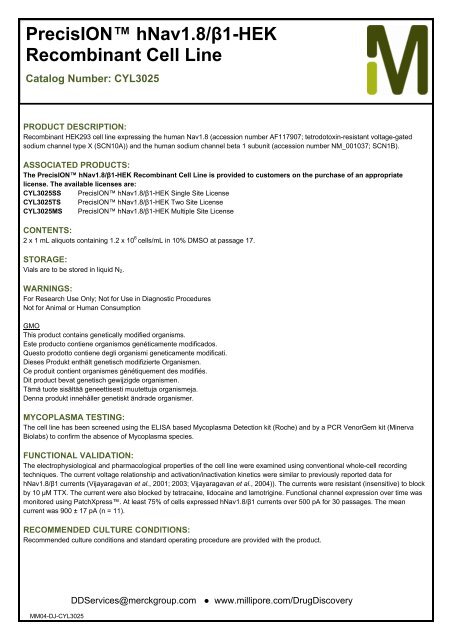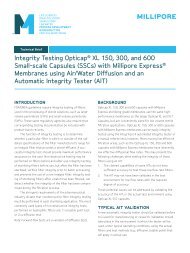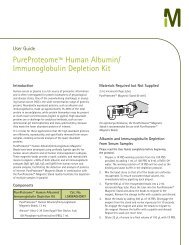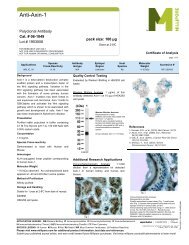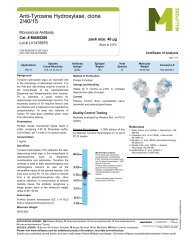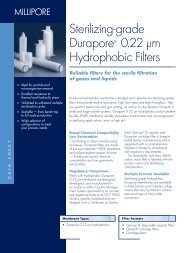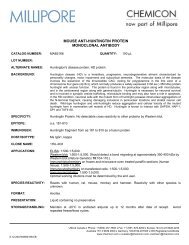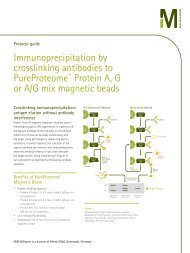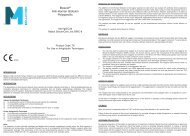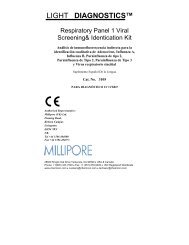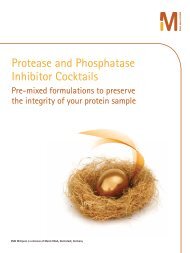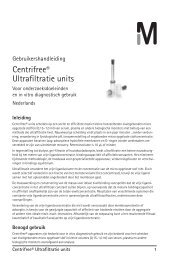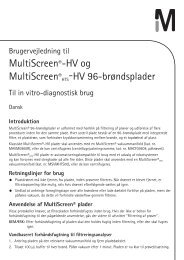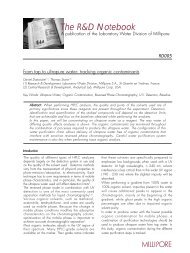CYL3025-MM04 hNav1.8.pdf - Millipore
CYL3025-MM04 hNav1.8.pdf - Millipore
CYL3025-MM04 hNav1.8.pdf - Millipore
You also want an ePaper? Increase the reach of your titles
YUMPU automatically turns print PDFs into web optimized ePapers that Google loves.
PrecisION hNav1.8/β1-HEK<br />
Recombinant Cell Line<br />
Catalog Number: <strong>CYL3025</strong><br />
PRODUCT DESCRIPTION:<br />
Recombinant HEK293 cell line expressing the human Nav1.8 (accession number AF117907; tetrodotoxin-resistant voltage-gated<br />
sodium channel type X (SCN10A)) and the human sodium channel beta 1 subunit (accession number NM_001037; SCN1B).<br />
ASSOCIATED PRODUCTS:<br />
The PrecisION hNav1.8/β1-HEK Recombinant Cell Line is provided to customers on the purchase of an appropriate<br />
license. The available licenses are:<br />
<strong>CYL3025</strong>SS PrecisION hNav1.8/β1-HEK Single Site License<br />
<strong>CYL3025</strong>TS PrecisION hNav1.8/β1-HEK Two Site License<br />
<strong>CYL3025</strong>MS PrecisION hNav1.8/β1-HEK Multiple Site License<br />
CONTENTS:<br />
2 x 1 mL aliquots containing 1.2 x 10 6 cells/mL in 10% DMSO at passage 17.<br />
STORAGE:<br />
Vials are to be stored in liquid N2.<br />
WARNINGS:<br />
For Research Use Only; Not for Use in Diagnostic Procedures<br />
Not for Animal or Human Consumption<br />
GMO<br />
This product contains genetically modified organisms.<br />
Este producto contiene organismos genéticamente modificados.<br />
Questo prodotto contiene degli organismi geneticamente modificati.<br />
Dieses Produkt enthält genetisch modifizierte Organismen.<br />
Ce produit contient organismes génétiquement des modifiés.<br />
Dit product bevat genetisch gewijzigde organismen.<br />
Tämä tuote sisältää geneettisesti muutettuja organismeja.<br />
Denna produkt innehåller genetiskt ändrade organismer.<br />
MYCOPLASMA TESTING:<br />
The cell line has been screened using the ELISA based Mycoplasma Detection kit (Roche) and by a PCR VenorGem kit (Minerva<br />
Biolabs) to confirm the absence of Mycoplasma species.<br />
FUNCTIONAL VALIDATION:<br />
The electrophysiological and pharmacological properties of the cell line were examined using conventional whole-cell recording<br />
techniques. The current voltage relationship and activation/inactivation kinetics were similar to previously reported data for<br />
hNav1.8/β1 currents (Vijayaragavan et al., 2001; 2003; Vijayaragavan et al., 2004)). The currents were resistant (insensitive) to block<br />
by 10 µM TTX. The current were also blocked by tetracaine, lidocaine and lamotrigine. Functional channel expression over time was<br />
monitored using PatchXpress. At least 75% of cells expressed hNav1.8/β1 currents over 500 pA for 30 passages. The mean<br />
current was 900 ± 17 pA (n = 11).<br />
RECOMMENDED CULTURE CONDITIONS:<br />
Recommended culture conditions and standard operating procedure are provided with the product.<br />
<strong>MM04</strong>-DJ-<strong>CYL3025</strong><br />
DDServices@merckgroup.com ● www.millipore.com/DrugDiscovery
PrecisION hNav1.8/β1-HEK<br />
Recombinant Cell Line<br />
Catalog Number: <strong>CYL3025</strong><br />
FUNCTIONAL VALIDATION:<br />
Introduction.<br />
The voltage-gated sodium channel α-subunit Nav1.8 (also known as hSCN10A, SNS and PN3) is expressed in high levels in<br />
mammalian adult dorsal root ganglion (DRG) neurons where it is involved in action potential initiation and transmission of nociceptive<br />
impulses (Leffler et al., 2007). Native sodium channels are multi-subunit complexes, composed of not only the pore forming α<br />
subunit, but also auxiliary β subunits. The β1 subunit is known to increase peak current amplitude as well as increasing sodium ion<br />
channel expression at the cell surface (Vijayaragavan et al., 2004).<br />
Electrophysiological Properties of the hNav1.8/β1 current.<br />
Whole-cell Patch Clamp Electrophysiology.<br />
Current/Voltage Relationship:<br />
Activation: Activation of the hNav1.8/β1 produced an inward current with slow inactivation kinetics (Figure 1). The channel<br />
activated at approximately -40 mV and reached its peak current at 20 mV (Figure 2). The hNav1.8/β1 channel had a half-activation<br />
voltage (Vi) of -1.2 ± 0.7 mV and a slope (k) of 11.4 ± 0.6 (Figure 3). This is close to previously reported values (V½ = -3 to 2.5 mV<br />
and k = 5.5 – 11.3; Rabert et al., 1998; Vijayaragavan et al., 2001; 2003; Vijayaragavan et al., 2004).<br />
Figure 1. Typical current traces for hNav1.8/β1 evoked by the depolarizing voltage steps.<br />
The currents were produced by 100 ms voltage steps from –90 to +60 mV in 10 mV increments. Sweep every 10 s.<br />
The cells were held at a holding potential of –90 mV. The voltage protocol used is shown in red.<br />
<strong>MM04</strong>-DJ-<strong>CYL3025</strong><br />
0.2 nA<br />
50 mV<br />
DDServices@merckgroup.com ● www.millipore.com/DrugDiscovery<br />
5 ms<br />
5 ms
PrecisION hNav1.8/β1-HEK<br />
Recombinant Cell Line<br />
Catalog Number: <strong>CYL3025</strong><br />
Figure 2. Typical Current-voltage (I/V) relationship for hNav1.8/β1.<br />
Figure 3. Conductance-voltage graph of the hNav1.8/β1 current.<br />
The conductance was normalized to peak conductance at +20 mV and plotted against membrane voltage. The<br />
voltage protocol used is shown (inset).<br />
<strong>MM04</strong>-DJ-<strong>CYL3025</strong><br />
-120 mV<br />
DDServices@merckgroup.com ● www.millipore.com/DrugDiscovery<br />
20 mV<br />
5 ms
PrecisION hNav1.8/β1-HEK<br />
Recombinant Cell Line<br />
Catalog Number: <strong>CYL3025</strong><br />
Inactivation:<br />
The hNav1.8/β1 channel had a half-inactivation voltage (Vi) of -47.6 ± 0.9 mV and a slope (k) of 9.5 ± 0.8 (Figure<br />
4). Again this is close to values reported previously (V½ = -40 to –63 mV and k = 7.1 – 12.9; Vijayaragavan et al.,<br />
2001; Vijayaragavan et al., 2004; Leffler et al., 2007).<br />
Figure 4. Steady-state inactivation of the hNav1.8/β1.<br />
The voltage protocol used is shown (inset).<br />
<strong>MM04</strong>-DJ-<strong>CYL3025</strong><br />
20 mV<br />
1 s<br />
DDServices@merckgroup.com ● www.millipore.com/DrugDiscovery
PrecisION hNav1.8/β1-HEK<br />
Recombinant Cell Line<br />
Catalog Number: <strong>CYL3025</strong><br />
Recovery from inactivation:<br />
In order to assess the time constant of recovery of inactivation at -110 mV following an inactivating 20 ms voltage<br />
step to 10 mV, a double pulse protocol was used. First, the membrane was stepped from the holding potential (-<br />
110 mV) to 10 mV for 20 ms (Pulse 1, P1). The holding potential of -110 mV was sufficient to remove any<br />
inactivation so that the subsequent test pulse to 10 mV produced maximal inward current (i.e. all channels were<br />
available for activation). Immediately after the step to 10 mV the voltage was returned to -110 mV for varying<br />
amounts of time ranging from 1 – 38.4 ms with each successive intervals increasing by 50% (interpulse duration).<br />
After each incremental change in time, the voltage was stepped back to 10 mV (Pulse 2, P2). This was to assess<br />
the amount of recovery from inactivation at each incremental time point at -110 mV, by comparing the amplitude of<br />
P2 (after returning to -110 mV) with P1. Clearly, if channels had fully recovered at a given incremental time point,<br />
then the amplitude of P2 would be the same as P1, hence P2/P1 = 1. However, if channels had only partially<br />
recovered at a given incremental time point, the amplitude of P2 would be smaller, so that P2/P1 =
PrecisION hNav1.8/β1-HEK<br />
Recombinant Cell Line<br />
Catalog Number: <strong>CYL3025</strong><br />
Pharmacological Properties of the hNav1.8/β1 current.<br />
Pharmacology - Tetrodotoxin:<br />
The puffer fish derived toxin, tetrodotoxin, has been found to block multiple sodium channels in the nanomolar<br />
range. The hNav1.8 channel is very resistant to block by TTX, with an IC50 of 60 - 80 µM (Akopian et al., 1996;<br />
Rabert et al., 1998). In order to conclusively demonstrate the functional expression of hNav1.8 currents, 10 µM<br />
TTX was tested on the inward currents evoked by stepping to a test potential of 20 mV from a holding potential of -<br />
90 mV (Figure 6). Currents following the addition of 10 µM TTX were 93.4 ± 1.8% (n = 11) of those preceding the<br />
addition of TTX.<br />
Figure 6. The effect of 10 µM tetrodotoxin on hNav1.8/β1 currents.<br />
Typical traces showing the effect of 10 µM tetrodotoxin. Sodium currents are shown before and in the presence of<br />
tetrodotoxin. Black trace represents inward current before addition of TTX and the red trace the current in the<br />
presence of TTX. The cells were held at a holding potential of –90 mV and then stepped to a test pulse to 20 mV<br />
for 20 ms at a frequency of 0.1 Hz.<br />
<strong>MM04</strong>-DJ-<strong>CYL3025</strong><br />
TTX 10 µM<br />
250 pA<br />
DDServices@merckgroup.com ● www.millipore.com/DrugDiscovery<br />
200<br />
5<br />
20 s
PrecisION hNav1.8/β1-HEK<br />
Recombinant Cell Line<br />
Catalog Number: <strong>CYL3025</strong><br />
Pharmacology – A-803467:<br />
A-803467 is a sodium channel blocker that potently blocks hNav1.8 with an IC50 in the nanomolar range whilst<br />
blocking other Nav channels in the micromolar range (Jarvis et al., 2007). hNav1.8 currents evoked by repetitive<br />
(10 Hz) 20 ms depolarizing pulses from a holding current of either –90 mV or –60 mV were blocked by 100 nM by<br />
42-43% at -90 mV and by 62-70% at -60 mV (Figure 7).<br />
Figure 7. The block of hNav1.8/β1 by 100 nM A-803467<br />
The upper panel shows peak inward current plotted for each consecutive pulse, before, in the presence of<br />
A803467 (red bar) and after wash off of drug using a Vhold of –90 mV (left) or –60 mV (right). The lower panel<br />
shows representative individual current traces at the indicated time points.<br />
<strong>MM04</strong>-DJ-<strong>CYL3025</strong><br />
DDServices@merckgroup.com ● www.millipore.com/DrugDiscovery
PrecisION hNav1.8/β1-HEK<br />
Recombinant Cell Line<br />
Catalog Number: <strong>CYL3025</strong><br />
Pharmacology – Tetracaine, Lidocaine and Lamotrigine:<br />
The potency of the block of the hNav1.8/β1 by tetracaine, lidocaine and lamotrigine when 50% of the channels are<br />
in the inactive state cells was assessed. Cells were voltage clamped at a holding potential of -90 mV then stepped<br />
to -50 mV (~ V½ inactivation) for 5 seconds followed by a test pulse to 20 mV. This was repeated every 10<br />
seconds. hNav1.8/β1 was blocked with IC50 values of 0.6 ± 0.2 µM (n = 9), 63.3 ± 12.2 µM (n = 6) and 202.3 ± 22.5<br />
µM (n = 6) for tetracaine, lidocaine and lamotrigine respectively (Figure 8). These values are in agreement with<br />
published findings (Poyraz et al., 2003; Jarvis et al., 2007).<br />
Figure 8. Block of hNav1.8/β1 current using tetracaine, lidocaine and lamotrigine.<br />
A. Dose-response curves of tetracaine, lidocaine and lamotrigine on the hNav1.8/β1 current. Voltage protocol<br />
shown in inset.<br />
B. Typical current traces showing the inhibition of hNav1.8 currents by increasing doses of lamotrigine. Control<br />
current before lamotrigine addition shown in black.<br />
A<br />
B<br />
<strong>MM04</strong>-DJ-<strong>CYL3025</strong><br />
1000 µM<br />
100 µM<br />
10 µM<br />
1 µM<br />
0.2 nA<br />
5 ms<br />
DDServices@merckgroup.com ● www.millipore.com/DrugDiscovery
PrecisION hNav1.8/β1-HEK<br />
Recombinant Cell Line<br />
Catalog Number: <strong>CYL3025</strong><br />
Stability of hNav1.8/β1–HEK293 Cell Line.<br />
PatchXpress Electrophysiology.<br />
The hNav1.8/β1–HEK293 cell line has stable expression for >30 passages.<br />
Figure 8. Stability of expression over passage.<br />
The upper panel shows the percentage of cells expressing a mean peak inward current >500 pA for cell passages<br />
9, 14, 19, 26. The numbers above each bar represent the number of cells sealed (out of a maximum of 16).<br />
<strong>MM04</strong>-DJ-<strong>CYL3025</strong><br />
DDServices@merckgroup.com ● www.millipore.com/DrugDiscovery
PrecisION hNav1.8/β1-HEK<br />
Recombinant Cell Line<br />
Catalog Number: <strong>CYL3025</strong><br />
Vectors:<br />
<strong>MM04</strong>-DJ-<strong>CYL3025</strong><br />
AhdI<br />
PvuI<br />
Amp<br />
PCIN5_NEWC<br />
4904 bps<br />
Polylinker: CMV-BamHI-NotI-hNav1.8-NotI-AscI-NdeI-EcoRI-IRES-neo<br />
4000<br />
3000<br />
HincII<br />
XhoI<br />
AvaI<br />
SphI<br />
HincII<br />
SspI<br />
hNav1.8‐pCIN5<br />
polyA<br />
XbaI<br />
BclI<br />
DDServices@merckgroup.com ● www.millipore.com/DrugDiscovery<br />
2000<br />
MluI<br />
HincII<br />
CMV promoter<br />
Neo<br />
1000<br />
BssHII<br />
SphI<br />
NdeI<br />
SnaBI<br />
IRES<br />
PstI<br />
BamHI<br />
ApaI<br />
NotI<br />
AvaI<br />
XhoI<br />
AscI<br />
BssHII<br />
NdeI<br />
ClaI<br />
HpaI<br />
HincII<br />
EcoRI
PrecisION hNav1.8/β1-HEK<br />
Recombinant Cell Line<br />
Catalog Number: <strong>CYL3025</strong><br />
Polylinker: CMV-KpnI-SacI-BamHI-hNav β1-NotI-IRES-hyg<br />
hNav1.8 Sequence (AF117907)<br />
hNav β1 Sequence (NM_001037)<br />
<strong>MM04</strong>-DJ-<strong>CYL3025</strong><br />
PvuII<br />
XhoI<br />
PvuII<br />
SphI<br />
4000<br />
Amp<br />
BclI<br />
SacI<br />
XbaI<br />
5000<br />
polyA<br />
SspI<br />
pCIH<br />
PCIH.SEQ<br />
5726 bps<br />
DDServices@merckgroup.com ● www.millipore.com/DrugDiscovery<br />
3000<br />
CMV promoter<br />
hNav β1‐pCIH<br />
Hygro<br />
1000<br />
2000<br />
NdeI<br />
IVS<br />
IRES<br />
PstI<br />
NdeI<br />
SacI<br />
KpnI<br />
SacI<br />
BamHI<br />
BstXI<br />
PstI<br />
SphI<br />
NotI<br />
ApaI<br />
KpnI
PrecisION hNav1.8/β1-HEK<br />
Recombinant Cell Line<br />
Catalog Number: <strong>CYL3025</strong><br />
References<br />
Akiba, I., Seki, T., Mori, M., Iizuka, M., Nishimura, S., Sasaki, S., Imoto, K. and Barsoumian, E.L. (2003). Stable<br />
expression and characterization of human PN1 and PN3 sodium channels. Receptors Channels 9, 291-299.<br />
Akopian, A.N., Sivilotti, L. and Wood, J.N. (1996). A tetrodotoxin-resistant voltage-gated sodium channel<br />
expressed by sensory neurons. Nature 379, 257-262.<br />
Jarvis, M.F., Honore, P., Shieh, C.C., Chapman, M., Joshi, S., Zhang, X.F., Kort, M., Carroll, W., Marron, B.,<br />
Atkinson, R., Thomas, J., Liu, D., Krambis, M., Liu, Y., McGaraughty, S., Chu, K., Roeloffs, R., Zhong, C., Mikusa,<br />
J.P., Hernandez, G., Gauvin, D., Wade, C., Zhu, C., Pai, M., Scanio, M., Shi, L., Drizin, I., Gregg, R., Matulenko,<br />
M., Hakeem, A., Gross, M., Johnson, M., Marsh, K., Wagoner, P.K., Sullivan, J.P., Faltynek, C.R. and Krafte, D.S.<br />
(2007). A-803467, a potent and selective Nav1.8 sodium channel blocker, attenuates neuropathic and<br />
inflammatory pain in the rat. Proc Natl Acad Sci U S A 104, 8520-8525.<br />
Leffler, A., Reiprich, A., Mohapatra, D.P. and Nau, C. (2007). Use-dependent block by lidocaine but not<br />
amitriptyline is more pronounced in tetrodotoxin (TTX)-Resistant Nav1.8 than in TTX-sensitive Na+ channels. J<br />
Pharmacol Exp Ther 320, 354-364.<br />
Poyraz, D., Brau, M.E., Wotka, F., Puhlmann, B., Scholz, A.M., Hempelmann, G., Kox, W.J. and Spies, C.D.<br />
(2003). Lidocaine and octanol have different modes of action at tetrodotoxin-resistant Na(+) channels of peripheral<br />
nerves. Anesth Analg 97, 1317-1324.<br />
Rabert, D.K., Koch, B.D., Ilnicka, M., Obernolte, R.A., Naylor, S.L., Herman, R.C., Eglen, R.M., Hunter, J.C. and<br />
Sangameswaran, L. (1998). A tetrodotoxin-resistant voltage-gated sodium channel from human dorsal root<br />
ganglia, hPN3/SCN10A. Pain 78, 107-114.<br />
Vijayaragavan, K., O'Leary, M.E. and Chahine, M. (2001). Gating properties of Na(v)1.7 and Na(v)1.8 peripheral<br />
nerve sodium channels. J Neurosci 21, 7909-7918.<br />
Vijayaragavan, K., Powell, A.J., Kinghorn, I.J. and Chahine, M. (2004). Role of auxiliary beta1-, beta2-, and beta3subunits<br />
and their interaction with Na(v)1.8 voltage-gated sodium channel. Biochem Biophys Res Commun 319,<br />
531-540.<br />
<strong>MM04</strong>-DJ-<strong>CYL3025</strong><br />
For research use only; not for use as a diagnostic.<br />
Unless otherwise stated in our catalog or other company documentation accompanying the product(s), our<br />
products are intended for research use only and are not to be used for any other purpose, which includes but is not<br />
limited to, unauthorized commercial uses, in vitro diagnostic uses, ex vivo or in vivo therapeutic uses or any type of<br />
consumption or application to humans or animals.<br />
Certain methods of sample preparation, screening, analysis or use of <strong>Millipore</strong> products may be covered by<br />
patents or other intellectual property rights held by others in various jurisdictions. <strong>Millipore</strong> does not encourage or<br />
support any unauthorized or unlicensed use of any third-party owned technology. In particular, <strong>Millipore</strong> does not<br />
presently possess a license to any patents relating to the use of <strong>Millipore</strong> products in compound screening.<br />
Purchase of any <strong>Millipore</strong> product does not imply or grant a license to any such patent to our customers.<br />
©2009: <strong>Millipore</strong> Corporation. All rights reserved. No part of these works may be reproduced in any form without<br />
permission in writing.<br />
PrecisION is a trademark of Merck KG&A,<br />
Darmstadt, Germany.. IonWorks HT is a<br />
trademark of Molecular Devices Corporation.<br />
DDServices@merckgroup.com ● www.millipore.com/DrugDiscovery


